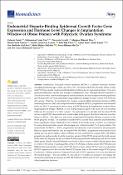Options
Endometrial Heparin-binding Epidermal Growth Factor Gene Expression And Hormone Level Changes In Implantation\r\nWindow Of Obese Women With Polycystic Ovarian Syndrome
Journal
Biomedicine
Date Issued
2023
Author(s)
Zulazmi Sutaji
Muhammad Azrai Abu
Nurainie Sayutti
Marjanu Hikmah Elias
Mohd Faizal Ahmad
Abdul Ghani Nur Azurah
Kah Teik Chew
Abdul Kadir Abdul Karim
Nor Haslinda Abd Aziz
Mohd Helmy Mokhtar
Reena Rahayu Md Zin
Zeti Azura Mohamed Hussein
DOI
10.3390/biomedicines11020276
Abstract
Introduction: Polycystic ovarian syndrome (PCOS) is a common endocrine disorder
amongst reproductive-age women, and 61% to 76% of women with PCOS are obese. Obese women
with PCOS are usually burdened with infertility problems due to implantation failure. Thus, progesterone treatment is usually used to improve implantation rates. Although Hb-EGF expression is
actively involved in endometrial receptivity and implantation, the data on heparin-binding epidermal
growth factor (Hb-EGF) expression following progesterone therapy in obese women with PCOS are
still lacking. Objective: To investigate the changes in serum follicle-stimulating hormone (FSH),
luteinising hormone (LH), dehydroepiandrosterone sulphate (DHEA), progesterone and oestradiol
levels and Hb-EGF expression in obese women with PCOS during the implantation window following progesterone therapy. Method: A total of 40 participants aged 18–40 years old were recruited
following the provision of written consent. The participants were divided into the obese PCOS,
normal-weight PCOS, obese fertile and normal-weight fertile groups. First blood collection was done
before ovulation. Then, daily oral micronised progesterone (Utrogestan 200 mg) was given to the
PCOS group for 10 days. The treatment was followed by a second blood collection and endometrial
tissue sampling by using a Pipelle de Cornier catheter. In the fertile group, ovulation was confirmed
by using ultrasound, and a second blood sample was collected on days 7 to 9 postovulation. The
serum levels of FSH, LH, DHEA, progesterone and oestradiol were measured in all participants.
Wilcoxon signed-rank test was used to compare FSH, LH, DHEA, progesterone and oestradiol levels
during pre- and postovulation. Mann–Whitney test was performed to compare FSH, LH, DHEA,
progesterone and oestradiol levels between two groups: (1) the PCOS group and the fertile group,
(2) the obese PCOS group and the non-obese PCOS group and (3) the obese group and the non-obese
fertile group. Result: Serum FSH levels were lower in obese women in their follicular phase than
in women with normal weight regardless of their PCOS status, whereas serum LH/FSH ratios and
DHEA levels were higher in women with PCOS than in women without PCOS. However, endometrial
Hb-EGF expression was lower in the obese PCOS group than in the normal-weight PCOS group.
Conclusions: Different patterns of hormonal levels and Hb-EGF expression levels were seen between
the studied groups. However, further in vitro and in vivo studies are needed to investigate the
mechanism underlying the changes in FSH, LH/FSH ratio, DHEA and Hb-EGF expression in PCOS
after progesterone treatment.
amongst reproductive-age women, and 61% to 76% of women with PCOS are obese. Obese women
with PCOS are usually burdened with infertility problems due to implantation failure. Thus, progesterone treatment is usually used to improve implantation rates. Although Hb-EGF expression is
actively involved in endometrial receptivity and implantation, the data on heparin-binding epidermal
growth factor (Hb-EGF) expression following progesterone therapy in obese women with PCOS are
still lacking. Objective: To investigate the changes in serum follicle-stimulating hormone (FSH),
luteinising hormone (LH), dehydroepiandrosterone sulphate (DHEA), progesterone and oestradiol
levels and Hb-EGF expression in obese women with PCOS during the implantation window following progesterone therapy. Method: A total of 40 participants aged 18–40 years old were recruited
following the provision of written consent. The participants were divided into the obese PCOS,
normal-weight PCOS, obese fertile and normal-weight fertile groups. First blood collection was done
before ovulation. Then, daily oral micronised progesterone (Utrogestan 200 mg) was given to the
PCOS group for 10 days. The treatment was followed by a second blood collection and endometrial
tissue sampling by using a Pipelle de Cornier catheter. In the fertile group, ovulation was confirmed
by using ultrasound, and a second blood sample was collected on days 7 to 9 postovulation. The
serum levels of FSH, LH, DHEA, progesterone and oestradiol were measured in all participants.
Wilcoxon signed-rank test was used to compare FSH, LH, DHEA, progesterone and oestradiol levels
during pre- and postovulation. Mann–Whitney test was performed to compare FSH, LH, DHEA,
progesterone and oestradiol levels between two groups: (1) the PCOS group and the fertile group,
(2) the obese PCOS group and the non-obese PCOS group and (3) the obese group and the non-obese
fertile group. Result: Serum FSH levels were lower in obese women in their follicular phase than
in women with normal weight regardless of their PCOS status, whereas serum LH/FSH ratios and
DHEA levels were higher in women with PCOS than in women without PCOS. However, endometrial
Hb-EGF expression was lower in the obese PCOS group than in the normal-weight PCOS group.
Conclusions: Different patterns of hormonal levels and Hb-EGF expression levels were seen between
the studied groups. However, further in vitro and in vivo studies are needed to investigate the
mechanism underlying the changes in FSH, LH/FSH ratio, DHEA and Hb-EGF expression in PCOS
after progesterone treatment.
Subjects
File(s)
Loading...
Name
Endometrial Heparin-Binding Epidermal Growth Factor Gene Expression and Hormone Level Changes in Implantation Window of Obese Women with Polscystic Ovarion Syndrome.pdf
Size
248.09 KB
Format
Adobe PDF
Checksum
(MD5):c244d7a720edfd096316104cb3bdda54